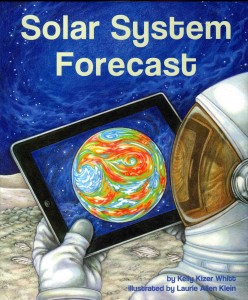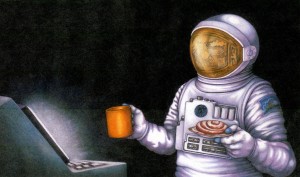Solar System Forecast was the book that immediately followed on the heels of Meet the Planets (and yes, i know i’m bopping all around the continuity spectrum in terms of writing behind-the-scenes illustration accounts of my books, but i simply have to go where whim and muse take me and today it’s all about weather) and when i first received the manuscript i was a little disheartened (seems to be a theme here, if you read the blog about “Balloon Trees”). For one thing – i had just finished illustrating the planet book and had poured my heart and soul and every pop culture sci fi nerdy geek reference fiber of my being into that project. There simply didn’t seem to be anything left to say (or draw) on the subject of Space.
For another thing (or B) – i didn’t want the illustration style of the solar book to look too similar to the planet book, but wasn’t exactly sure how to alter it (or even if i could).
But more importantly (#3, or C, if you’re keeping track) – it was a book about weather! What do you do with that? Granted, there are some amazing, dramatic, and beautiful visuals associated with storms, and cloud formations; and a couple illustrations like that could be pretty interesting. But 13 pages of landscape variations – for a children’s picture book – just sounded boring to me. Somewhere around the 5th or 6th noctilucent cloud formation or occluded front picture i’m pretty sure the reader would have discarded the book in favor of a video game or fighting with a sibling. Plus – how do you even depict things like the seasons, or wind, or heat, on planets with no atmosphere and a surface of rock or gas? No flowers to indicate Spring. No colorful leaves to convey Fall. No thrashing tree branches or amber waves of grain to suggest wind.
And on top of everything else, there wasn’t even an actual story here. No continuous narrative, no recurring characters; just a series of weather reports relating a “different state of the atmosphere at a given time and place, described by specification of variables such as temperature, moisture, wind velocity, and pressure” (Definition of weather, as found in The American Heritage Dictionary of the English Language). SEE! You try and draw a picture of that!
I was stumped. Stymied. Flummoxed. Perplexed. Baffled. Confounded. Mystified. Bewildered. I could not see a way to link the random reports into cohesive visuals that would not only convey the abstract nature of the weather account described, but also be interesting and entertaining for children (and Me) to look at. And then one morning – things suddenly fell into place. I watched my husband get ready for work.
Inspiration really does come from the strangest and unexpected sources. My husband is a pilot, and very often leaves for work at dark:thirty in the wee hours of the morning. On this particular day i happened to wake up (usually i sleep thru his pre-dawn routine – particularly when it’s at some insane hour ) – the room was dark, everything was in shadow with the only light coming from the blue glow of the TV, and there illuminated in the glow was my husband, standing in his uniform, coffee mug in hand, watching The Weather Channel. [NOTE TO FLYING PUBLIC: Pilots obviously get their weather information from highly specialized and official sources, my husband was just getting a rough idea of what his day was going to be like and if he needed to pack his long-johns). There it was – the opening scene for the first page of Solar System Forecast!
Since the whole premise of the book is that we (as in Humans) are technologically advanced enough to travel to different planets and moons, and go there frequently enough that we care about what the weather is doing on these other worlds, i opened the book with a picture of how one such typical space traveler would routinely begin his day. Showered and dressed, with a morning cup of coffee and breakfast Danish (part of the humor coming from the delicate little Franciscan wear plate in his thickly gloved hand), watching the weather report before heading off to the “office” (whether it be a rocket, or space lab, or an interstellar cosmic cubicle). And yes, the helmet visor is purposely closed because i thought it added another element of silly lunacy the audience would appreciate (i mean – how is the guy gonna have his breakfast, right??).
From that point on The Weather Channel, and all the different ways we can access weather reports (you know they have an App for that), became the unifying theme of the book. Some pages came easy, some were a bit more complex. One i thought i’d have to completely redraw but managed to save. One i did have to redo, from scratch. And on the last page there is a fun little unexpected surprise, so there is certainly quite a bit to share and if i can keep from getting distracted by shiny objects i’ll attempt to describe all the little details.
Bottom line – there really is a way to illustrate weather in space!

